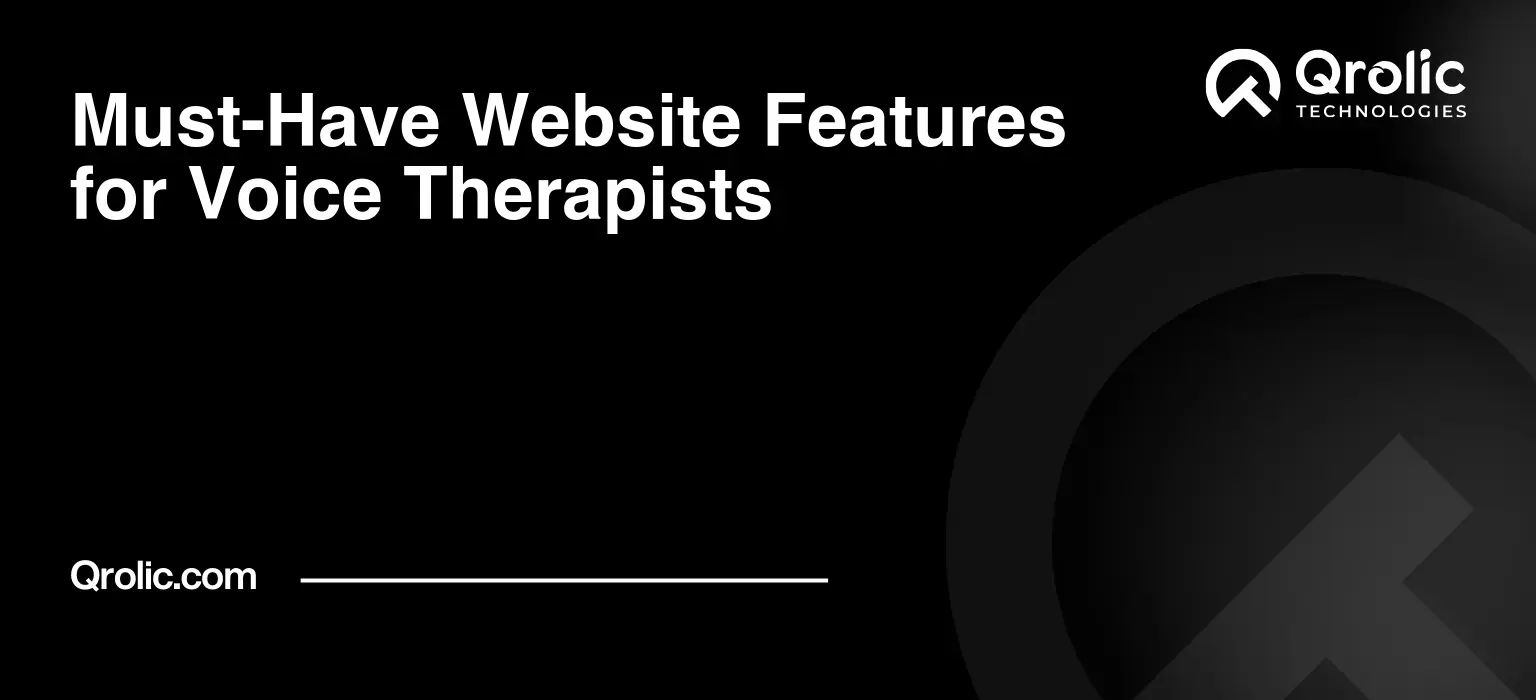Voice therapy, a specialized field dedicated to helping individuals improve and rehabilitate their voices, demands a unique approach to online presence. A voice therapist’s website isn’t just a digital brochure; it’s a crucial tool for connecting with potential patients, establishing credibility, and streamlining practice operations. In today’s digital age, a robust and user-friendly website is essential for any voice therapist seeking to thrive. This comprehensive guide explores the must-have website features that will transform your online presence and empower your practice.
Quick Summary:
- Create a warm, informative, and patient-focused website.
- Use online booking and a secure patient portal.
- Optimize for mobile, security, SEO, and accessibility.
- Regularly update and maintain your website for success.
Table of Contents
- 1. Compelling Introduction: Connecting with Your Audience Emotionally
- 1.1 A Warm and Welcoming Message
- 1.2 Showcase Your Empathy and Expertise
- 1.3 Call to Action Above the Fold
- 2. Detailed Information on Voice Therapy Services
- 2.1 Comprehensive List of Conditions Treated
- 2.2 Explanation of Therapy Techniques
- 2.3 Benefits of Voice Therapy
- 3. Integrated Online Booking System: Streamlining the Scheduling Process
- 3.1 24/7 Availability
- 3.2 Real-Time Availability
- 3.3 Automated Reminders
- 3.4 Integration with Your Calendar
- 3.5 Payment Processing
- 3.6 Key Features to Look for in a Booking System:
- 4. Secure and HIPAA-Compliant Patient Portal
- 4.1 Secure Messaging
- 4.2 Access to Medical Records
- 4.3 Online Forms and Questionnaires
- 4.4 Payment Options
- 4.5 Appointment Management
- 4.6 Enhanced Security Measures
- 5. Engaging Content: Building Authority and Trust
- 5.1 Blog Posts
- 5.2 Videos
- 5.3 Downloadable Resources
- 5.4 Content Optimization
- 6. About Us Page: Building Personal Connection
- 6.1 Your Credentials and Experience
- 6.2 Your Philosophy and Approach
- 6.3 Your Team (If Applicable)
- 6.4 Your Mission and Vision
- 6.5 Professional Headshots
- 6.6 Awards and Recognition
- 7. Contact Information and Location Details
- 7.1 Phone Number
- 7.2 Email Address
- 7.3 Physical Address (If Applicable)
- 7.4 Map Integration
- 7.5 Contact Form
- 7.6 Social Media Links
- 8. Mobile Responsiveness: Reaching Patients on Any Device
- 8.1 Responsive Design
- 8.2 Mobile-Friendly Navigation
- 8.3 Fast Loading Speed
- 8.4 Touch-Friendly Elements
- 9. Website Security: Protecting Patient Data
- 9.1 SSL Certificate
- 9.2 Strong Passwords
- 9.3 Regular Backups
- 9.4 Security Plugins
- 9.5 Regular Updates
- 10. Search Engine Optimization (SEO): Helping Patients Find You
- 10.1 Keyword Research
- 10.2 On-Page Optimization
- 10.3 Off-Page Optimization
- 10.4 Local SEO
- 10.5 Content Marketing
- 11. Accessibility: Making Your Website Inclusive
- 11.1 WCAG Compliance
- 11.2 Alternative Text for Images
- 11.3 Keyboard Navigation
- 11.4 Color Contrast
- 11.5 Captions for Videos
- 12. Analytics and Tracking: Measuring Your Success
- 12.1 Google Analytics
- 12.2 Conversion Tracking
- 12.3 Regular Reporting
- 12.4 A/B Testing
- 13. Testimonials and Reviews: Building Trust and Credibility
- 13.1 Patient Testimonials
- 13.2 Online Reviews
- 13.3 Respond to Reviews
- 13.4 Use Review Schema Markup
- 14. Legal Considerations: Ensuring Compliance
- 14.1 Privacy Policy
- 14.2 Terms of Service
- 14.3 HIPAA Compliance
- 14.4 ADA Compliance
- 14.5 GDPR Compliance
- 15. Qrolic Technologies: Your Partner in Building a Successful Voice Therapy Website
- 15.1 Customized Website Design
- 15.2 Integrated Booking System
- 15.3 Secure Patient Portal
- 15.4 SEO Optimization
- 15.5 Ongoing Support and Maintenance
- 16. Regular Updates and Maintenance: Keeping Your Website Fresh
- 16.1 Software Updates
- 16.2 Content Updates
- 16.3 Security Monitoring
- 16.4 Performance Monitoring
- 16.5 Backup and Recovery
- Conclusion: Investing in Your Online Success
1. Compelling Introduction: Connecting with Your Audience Emotionally
Your website’s homepage is your first impression. Make it count. Avoid clinical jargon and instead focus on conveying empathy and understanding. Potential patients often arrive on your site feeling vulnerable and unsure. Your introduction should immediately reassure them that they’ve come to the right place.
1.1 A Warm and Welcoming Message
Start with a headline that speaks directly to their needs and anxieties. Examples include:
- “Rediscover Your Voice: Compassionate Voice Therapy for a Confident You.”
- “Struggling with Your Voice? We Can Help You Find It Again.”
- “Unlock Your Vocal Potential: Personalized Voice Therapy for Lasting Results.”
The accompanying text should briefly explain what voice therapy is and the range of conditions you treat. Use simple, relatable language.
1.2 Showcase Your Empathy and Expertise
- Patient Testimonials: Include video or written testimonials from satisfied patients. Hearing from others who have successfully navigated voice therapy can be incredibly reassuring.
- Your Story: Share your personal journey as a voice therapist. Why did you choose this profession? What motivates you? This helps build trust and rapport.
- Visuals: Use high-quality images and videos that evoke positive emotions. Avoid stock photos that feel generic. Consider images of you interacting with patients (with their consent, of course), or calming nature scenes.
1.3 Call to Action Above the Fold
Make it easy for visitors to take the next step. Place a clear and prominent call-to-action (CTA) above the fold (the portion of the website visible without scrolling). Examples include:
- “Schedule a Consultation”
- “Learn More About Voice Therapy”
- “Get a Free Vocal Assessment”
2. Detailed Information on Voice Therapy Services
Clearly and comprehensively describe the voice therapy services you offer. Potential patients need to understand the conditions you treat and the techniques you employ.
2.1 Comprehensive List of Conditions Treated
Provide a detailed list of conditions you treat, using both technical and layman’s terms. This improves SEO and ensures that patients can find your website when searching for specific conditions. Examples include:
- Voice Disorders: Vocal Cord Nodules, Vocal Cord Polyps, Vocal Cord Paralysis, Laryngitis, Spasmodic Dysphonia, Muscle Tension Dysphonia (MTD), Voice Tremor, Vocal Cord Dysfunction (VCD)/Paradoxical Vocal Fold Movement (PVFM)
- Speech Disorders: Stuttering, Cluttering, Articulation Disorders
- Resonance Disorders: Hypernasality, Hyponasality
- Swallowing Disorders (Dysphagia): Difficulty Swallowing Foods or Liquids
- Professional Voice Users: Vocal Training for Singers, Actors, Teachers, Public Speakers
2.2 Explanation of Therapy Techniques
Describe the different voice therapy techniques you use. Again, use simple and understandable language. Examples include:
- Vocal Function Exercises: A series of exercises designed to strengthen and coordinate the vocal muscles.
- Resonant Voice Therapy: A technique focused on optimizing vocal resonance and reducing vocal effort.
- Lee Silverman Voice Treatment (LSVT LOUD): A program specifically designed for individuals with Parkinson’s disease to improve vocal loudness and clarity.
- Manual Therapy: Using hands-on techniques to release tension in the neck and laryngeal muscles.
- Biofeedback: Using visual or auditory feedback to help patients become aware of and control their vocal muscles.
2.3 Benefits of Voice Therapy
Clearly outline the benefits of voice therapy for each condition you treat. What can patients expect to achieve? Examples include:
- Improved Vocal Quality: Clearer, stronger, and more resonant voice.
- Reduced Vocal Fatigue: Ability to speak for longer periods without strain.
- Increased Vocal Range: Greater control over pitch and volume.
- Pain Relief: Reduced pain and discomfort associated with vocal tension.
- Improved Communication: More effective and confident communication skills.
- Enhanced Quality of Life: Greater participation in social and professional activities.
3. Integrated Online Booking System: Streamlining the Scheduling Process
An online booking system is a game-changer for voice therapy practices. It simplifies the scheduling process, reduces administrative burden, and improves patient satisfaction.
3.1 24/7 Availability
Allow patients to book appointments anytime, day or night. This is particularly convenient for busy individuals who may not be able to call during office hours.
3.2 Real-Time Availability
Display your real-time availability, preventing double-bookings and scheduling conflicts.
3.3 Automated Reminders
Send automated appointment reminders via email or SMS to reduce no-shows.
3.4 Integration with Your Calendar
Seamlessly integrate the booking system with your existing calendar (e.g., Google Calendar, Outlook Calendar).
3.5 Payment Processing
Integrate secure payment processing to allow patients to pay for appointments online.
3.6 Key Features to Look for in a Booking System:
- Customizable Appointment Types: Define different appointment types (e.g., initial consultation, therapy session, follow-up) with varying durations and prices.
- Buffer Times: Set buffer times between appointments to allow for preparation and administrative tasks.
- Multiple Locations: If you have multiple locations, allow patients to choose their preferred location.
- Reporting and Analytics: Track appointment bookings, no-shows, and revenue.
Examples of Online Booking Systems: Acuity Scheduling, Calendly, SimplyBook.me
4. Secure and HIPAA-Compliant Patient Portal
A secure patient portal is essential for protecting patient privacy and streamlining communication. It provides a central hub for patients to access their information, communicate with you, and manage their care.
4.1 Secure Messaging
Enable secure messaging between you and your patients, ensuring HIPAA compliance. Avoid using email for sensitive information.
4.2 Access to Medical Records
Allow patients to access their medical records, including treatment plans, progress notes, and invoices.
4.3 Online Forms and Questionnaires
Provide online forms and questionnaires that patients can complete before their appointments, saving time during the initial consultation.
4.4 Payment Options
Allow patients to pay their bills online through the patient portal.
4.5 Appointment Management
Enable patients to view, reschedule, and cancel appointments through the portal.
4.6 Enhanced Security Measures
- Two-Factor Authentication: Implement two-factor authentication for added security.
- Data Encryption: Ensure that all patient data is encrypted both in transit and at rest.
- Regular Security Audits: Conduct regular security audits to identify and address vulnerabilities.
- HIPAA Compliance: Ensure that the patient portal is fully HIPAA compliant.
5. Engaging Content: Building Authority and Trust
Create valuable and engaging content that educates and informs potential patients about voice therapy. This not only builds trust and authority but also improves your website’s SEO.
5.1 Blog Posts
Write regular blog posts on topics related to voice therapy. Examples include:
- “Understanding Vocal Cord Nodules: Causes, Symptoms, and Treatment”
- “The Benefits of Voice Therapy for Professional Singers”
- “How to Improve Your Vocal Projection for Public Speaking”
- “Tips for Preventing Vocal Strain and Fatigue”
- “What to Expect During Your First Voice Therapy Session”
5.2 Videos
Create informative videos about voice therapy. Examples include:
- Introduction to Voice Therapy: A general overview of the field.
- Exercises and Techniques: Demonstrations of common voice therapy exercises.
- Patient Success Stories: Video testimonials from satisfied patients.
- “Ask a Voice Therapist” Q&A: Answer common questions from patients.
5.3 Downloadable Resources
Offer downloadable resources, such as checklists, guides, and worksheets. Examples include:
- “Vocal Warm-Up Exercises for Singers”
- “Guide to Protecting Your Voice at Work”
- “Checklist for Identifying Potential Voice Problems”
5.4 Content Optimization
- Keyword Research: Identify relevant keywords that potential patients are searching for.
- SEO Optimization: Optimize your content for search engines by using relevant keywords, meta descriptions, and alt tags.
- Readability: Write in a clear and concise style that is easy to understand.
- Visual Appeal: Use images and videos to break up text and make your content more engaging.
6. About Us Page: Building Personal Connection
Your “About Us” page is your opportunity to showcase your expertise, experience, and personality. It’s crucial for building trust and establishing a personal connection with potential patients.
6.1 Your Credentials and Experience
Clearly list your credentials, certifications, and experience as a voice therapist. Include information about your education, training, and any specialized areas of expertise.
6.2 Your Philosophy and Approach
Describe your philosophy and approach to voice therapy. What makes your practice unique? What are your core values?
6.3 Your Team (If Applicable)
If you have a team, introduce each member and highlight their qualifications and experience.
6.4 Your Mission and Vision
Share your mission and vision for your practice. What are you striving to achieve?
6.5 Professional Headshots
Include professional headshots of yourself and your team members.
6.6 Awards and Recognition
Highlight any awards or recognition you have received.
7. Contact Information and Location Details
Make it easy for potential patients to contact you. Provide clear and prominent contact information on every page of your website.
7.1 Phone Number
Display your phone number prominently.
7.2 Email Address
Provide a professional email address.
7.3 Physical Address (If Applicable)
If you have a physical location, provide your full address.
7.4 Map Integration
Embed a Google Maps integration to show your location and provide directions.
7.5 Contact Form
Include a contact form for potential patients to submit inquiries.
7.6 Social Media Links
Link to your social media profiles.
8. Mobile Responsiveness: Reaching Patients on Any Device
Ensure that your website is fully mobile responsive, meaning that it adapts seamlessly to different screen sizes and devices. A significant portion of website traffic now comes from mobile devices, so it’s crucial to provide a positive user experience on smartphones and tablets.
8.1 Responsive Design
Use a responsive design framework to ensure that your website looks and functions flawlessly on all devices.
8.2 Mobile-Friendly Navigation
Optimize your navigation for mobile devices, making it easy for users to find what they’re looking for.
8.3 Fast Loading Speed
Optimize your website for fast loading speed on mobile devices. slow loading times can lead to a high bounce rate.
8.4 Touch-Friendly Elements
Ensure that all buttons and links are touch-friendly and easy to tap on mobile devices.
9. Website Security: Protecting Patient Data
Website security is paramount, especially when dealing with sensitive patient information. Implement robust security measures to protect your website from cyber threats.
9.1 SSL Certificate
Install an SSL certificate to encrypt data transmitted between your website and visitors.
9.2 Strong Passwords
Use strong passwords for all website accounts.
9.3 Regular Backups
Perform regular backups of your website to prevent data loss.
9.4 Security Plugins
Use security plugins to protect your website from malware and other threats.
9.5 Regular Updates
Keep your website software and plugins up to date to patch security vulnerabilities.
10. Search Engine Optimization (SEO): Helping Patients Find You
SEO is the process of optimizing your website to rank higher in search engine results pages (SERPs). A strong SEO strategy is essential for attracting new patients to your practice.
10.1 Keyword Research
Identify relevant keywords that potential patients are searching for.
10.2 On-Page Optimization
Optimize your website content for search engines by using relevant keywords, meta descriptions, and alt tags.
10.3 Off-Page Optimization
Build high-quality backlinks from other websites to improve your website’s authority.
10.4 Local SEO
Optimize your website for local search by creating a Google My Business listing and targeting local keywords.
10.5 Content Marketing
Create valuable and engaging content that attracts and engages potential patients.
11. Accessibility: Making Your Website Inclusive
Ensure that your website is accessible to individuals with disabilities. This not only demonstrates your commitment to inclusivity but also improves your website’s usability for everyone.
11.1 WCAG Compliance
Follow the Web Content Accessibility Guidelines (WCAG) to ensure that your website is accessible to individuals with disabilities.
11.2 Alternative Text for Images
Provide alternative text for all images.
11.3 Keyboard Navigation
Ensure that your website can be navigated using a keyboard.
11.4 Color Contrast
Use sufficient color contrast between text and background.
11.5 Captions for Videos
Provide captions for all videos.
12. Analytics and Tracking: Measuring Your Success
Use website analytics to track your website’s performance and identify areas for improvement.
12.1 Google Analytics
Install Google Analytics to track website traffic, user behavior, and conversions.
12.2 Conversion Tracking
Set up conversion tracking to measure the effectiveness of your marketing campaigns.
12.3 Regular Reporting
Review your website analytics regularly to identify trends and patterns.
12.4 A/B Testing
Use A/B testing to optimize your website’s design and content.
13. Testimonials and Reviews: Building Trust and Credibility
Showcase positive testimonials and reviews from satisfied patients to build trust and credibility.
13.1 Patient Testimonials
Display patient testimonials prominently on your website.
13.2 Online Reviews
Encourage patients to leave reviews on Google, Yelp, and other online review platforms.
13.3 Respond to Reviews
Respond to both positive and negative reviews in a professional and timely manner.
13.4 Use Review Schema Markup
Implement review schema markup to display star ratings in search engine results.
14. Legal Considerations: Ensuring Compliance
Ensure that your website complies with all relevant legal requirements, including HIPAA, ADA, and GDPR.
14.1 Privacy Policy
Create a privacy policy that outlines how you collect, use, and protect patient data.
14.2 Terms of Service
Create terms of service that govern the use of your website.
14.3 HIPAA Compliance
Ensure that your website is fully HIPAA compliant if you are collecting or transmitting protected health information (PHI).
14.4 ADA Compliance
Ensure that your website is accessible to individuals with disabilities in compliance with the Americans with Disabilities Act (ADA).
14.5 GDPR Compliance
Ensure that your website complies with the General Data Protection Regulation (GDPR) if you are collecting data from individuals in the European Union (EU).
15. Qrolic Technologies: Your Partner in Building a Successful Voice Therapy Website
Qrolic Technologies (https://qrolic.com/) specializes in crafting exceptional digital solutions for healthcare professionals, including voice therapists. Understanding the unique needs of your practice, Qrolic Technologies can develop a custom website that incorporates all the must-have features discussed in this article.
15.1 Customized Website Design
Qrolic Technologies will create a visually appealing and user-friendly website that reflects your brand and resonates with your target audience.
15.2 Integrated Booking System
They can integrate a seamless online booking system, allowing patients to schedule appointments with ease.
15.3 Secure Patient Portal
Qrolic Technologies can develop a secure and HIPAA-compliant patient portal for enhanced communication and data management.
15.4 SEO Optimization
Their team of SEO experts will optimize your website to rank higher in search engine results, driving more traffic and potential patients to your practice.
15.5 Ongoing Support and Maintenance
Qrolic Technologies provides ongoing support and maintenance to ensure that your website remains secure, up-to-date, and effective.
Partner with Qrolic Technologies to build a website that empowers your voice therapy practice and helps you connect with more patients.
16. Regular Updates and Maintenance: Keeping Your Website Fresh
Your website is not a static entity. It requires regular updates and maintenance to remain secure, functional, and effective.
16.1 Software Updates
Keep your website software and plugins up to date to patch security vulnerabilities and ensure compatibility.
16.2 Content Updates
Regularly update your website content to keep it fresh and engaging.
16.3 Security Monitoring
Monitor your website for security threats and vulnerabilities.
16.4 Performance Monitoring
Monitor your website’s performance to ensure that it is loading quickly and functioning properly.
16.5 Backup and Recovery
Regularly back up your website to prevent data loss and ensure that you can quickly recover from any issues.
Conclusion: Investing in Your Online Success
A well-designed and optimized website is a critical investment for any voice therapist seeking to attract new patients, streamline practice operations, and establish a strong online presence. By incorporating the must-have features outlined in this guide, you can create a website that empowers your practice and helps you achieve your goals. Remember that your website is a dynamic tool that requires ongoing attention and maintenance. By staying up-to-date with the latest trends and technologies, you can ensure that your website remains a valuable asset for your practice for years to come.






